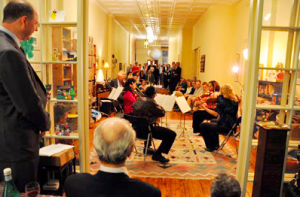The pop-up restaurant phenomenon is old news at this point. But good news for all those intrepid diners eating Ludo Lefebvre-style dishes in someone’s living room–you could have fugues and sonatas playing along with each course. Chamber orchestras are staging a comeback, capitalizing on flexibility and low overhead to thrive–often in unlikely places. An empty church, grammar school classrooms, someone’s living room, even alleys and subway stations, all are venues for a strong revival of live classical performances. While debt-strapped traditional symphony orchestras are closing, chamber orchestras are growing. Nearly three dozen new orchestras have launched since 2000, according to the League of American Orchestras.
The Knickerbocker Chamber Orchestra in lower Manhattan often plays in the lofts and dining rooms of its patrons. With one full-time staff member and no office, founder/composer Gary Fagin keeps his musicians nimble. One event may have a group of 12 strings while another features the entire 33-piece ensemble. But no matter where or what the orchestra plays, one thing remains constant: it always ends with a waltz.
Another small orchestra in the Los Angeles arts district played its first concert at a skateboarding park. Traction Avenue Chamber Orchestra led by not-quite-30 year old Ali Helnwein, will even play on rooftops and other places where young people hang out. Far from being bored with Baroque and modern classical pieces, Helnwein asserts that younger music lovers are eager to hear more but often don’t bother with huge concert halls and correspondingly high ticket prices. Many chamber orchestras give free concerts although others intend to build theirs as a viable business.
Whichever way they go, chamber music ensembles may bring the classics back to the table.


